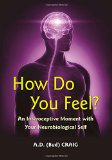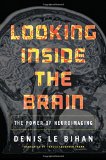December 15, 2014

Feeling Smart: Why Our Emotions Are More Rational Than We Think by Eyal Winter (PublicAffairs, 2014)
(kindle ed.), (amazon.co.uk), (UK kindle ed.)
Book description from the publisher:
Which is smarter—your head or your gut? It’s a familiar refrain: you’re getting too emotional. Try and think rationally. But is it always good advice?
In this surprising book, Eyal Winter asks a simple question: why do we have emotions? If they lead to such bad decisions, why hasn’t evolution long since made emotions irrelevant? The answer is that, even though they may not behave in a purely logical manner, our emotions frequently lead us to better, safer, more optimal outcomes.
In fact, as Winter discovers, there is often logic in emotion, and emotion in logic. For instance, many mutually beneficial commitments—such as marriage, or being a member of a team—are only possible when underscored by emotion rather than deliberate thought. The difference between pleasurable music and bad noise is mathematically precise; yet it is also something we feel at an instinctive level. And even though people are usually overconfident—how can we all be above average?—we often benefit from our arrogance.
Feeling Smart brings together game theory, evolution, and behavioral science to produce a surprising and very persuasive defense of how we think, even when we don’t.
Comments (0)
- cognitive science,new books,psychology
December 9, 2014

How Do You Feel?: An Interoceptive Moment with Your Neurobiological Self by A.D. (Bud) Craig (Princeton University Press, 2014)
(kindle ed.), (amazon.co.uk), (UK kindle ed.)
Book description from the publisher:
How Do You Feel? brings together startling evidence from neuroscience, psychology, and psychiatry to present revolutionary new insights into how our brains enable us to experience the range of sensations and mental states known as feelings. Drawing on his own cutting-edge research, neurobiologist Bud Craig has identified an area deep inside the mammalian brain–the insular cortex–as the place where interoception, or the processing of bodily stimuli, generates feelings. He shows how this crucial pathway for interoceptive awareness gives rise in humans to the feeling of being alive, vivid perceptual feelings, and a subjective image of the sentient self across time. Craig explains how feelings represent activity patterns in our brains that signify emotions, intentions, and thoughts, and how integration of these patterns is driven by the unique energy needs of the hominid brain. He describes the essential role of feelings and the insular cortex in such diverse realms as music, fluid intelligence, and bivalent emotions, and relates these ideas to the philosophy of William James and even to feelings in dogs.
How Do You Feel? is also a compelling insider’s account of scientific discovery, one that takes readers behind the scenes as the astonishing answer to this neurological puzzle is pursued and pieced together from seemingly unrelated fields of scientific inquiry. This book will fundamentally alter the way that neuroscientists and psychologists categorize sensations and understand the origins and significance of human feelings.
How do you feel? Lecture by Bud Craig. from Hälsouniversitetet on Vimeo.
Comments (0)
- cognitive science,new books
November 22, 2014

Looking Inside the Brain: The Power of Neuroimaging by Denis Le Bihan, tr. by Teresa Lavender Fagan (Princeton University Press, 2014)
(kindle ed.), (amazon.co.uk), (UK kindle ed.)
Book description from the publisher:
It is now possible to witness human brain activity while we are talking, reading, or thinking, thanks to revolutionary neuroimaging techniques like magnetic resonance imaging (MRI). These groundbreaking advances have opened infinite fields of investigation–into such areas as musical perception, brain development in utero, and faulty brain connections leading to psychiatric disorders–and have raised unprecedented ethical issues. In Looking Inside the Brain, one of the leading pioneers of the field, Denis Le Bihan, offers an engaging account of the sophisticated interdisciplinary research in physics, neuroscience, and medicine that have led to the remarkable neuroimaging methods that give us a detailed look into the human brain.
Introducing neurological anatomy and physiology, Le Bihan walks readers through the historical evolution of imaging technology–from the x-ray and CT scan to the PET scan and MRI–and he explains how neuroimaging uncovers afflictions like stroke or cancer and the workings of higher-order brain activities, such as language skills. Le Bihan also takes readers on a behind-the-scenes journey through NeuroSpin, his state-of-the-art neuroimaging laboratory, and goes over the cutting-edge scanning devices currently being developed. Considering what we see when we look at brain images, Le Bihan weighs what might be revealed about our thoughts and unconscious, and discusses how far this technology might go in the future.
Beautifully illustrated in color, Looking Inside the Brain presents the trailblazing story of the scanning techniques that provide keys to previously unimagined knowledge of our brains and our selves.
Google Books preview:
Comments (0)
- cognitive science,new books
November 18, 2014

The Future of the Brain: Essays by the World’s Leading Neuroscientists ed. by Gary Marcus and Jeremy Freeman (Princeton University Press, 2014)
(kindle ed.), (amazon.co.uk), (UK kindle ed.)
Book description from the publisher:
Including a chapter by 2014 Nobel laureates May-Britt Moser and Edvard Moser
An unprecedented look at the quest to unravel the mysteries of the human brain, The Future of the Brain takes readers to the absolute frontiers of science. Original essays by leading researchers such as Christof Koch, George Church, Olaf Sporns, and May-Britt and Edvard Moser describe the spectacular technological advances that will enable us to map the more than eighty-five billion neurons in the brain, as well as the challenges that lie ahead in understanding the anticipated deluge of data and the prospects for building working simulations of the human brain. A must-read for anyone trying to understand ambitious new research programs such as the Obama administration’s BRAIN Initiative and the European Union’s Human Brain Project, The Future of the Brain sheds light on the breathtaking implications of brain science for medicine, psychiatry, and even human consciousness itself.
Contributors include: Misha Ahrens, Ned Block, Matteo Carandini, George Church, John Donoghue, Chris Eliasmith, Simon Fisher, Mike Hawrylycz, Sean Hill, Christof Koch, Leah Krubitzer, Michel Maharbiz, Kevin Mitchell, Edvard Moser, May-Britt Moser, David Poeppel, Krishna Shenoy, Olaf Sporns, Anthony Zador.
Google Books preview:
Comments (0)
- cognitive science,new books






